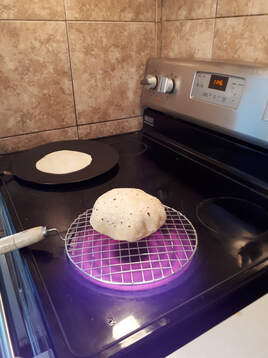|
In this photo, we are cooking rooti on the electric stove top.  The kitchen in my childhood home had two doors opening out to two corresponding verandahs. A nice sized room with plenty of sunshine coming in during the two months of really chilly temperatures with the added luxury of turning into a shadowy haven during the summer months. This ideal set up was challenged by rains during monsoon. We thumbed our nose at pouring rain by carrying cooked food from the kitchen to the dining room located in the main house, crossing the courtyard under shelter of a large black umbrella. My earliest recollection of our kitchen is of Ma sitting on a peera (low wooden stool) in front of the unun while our cook/ helper rinsed and washed, cut and sliced vegetables fresh from the market. The unun (Bengali term) or Chulha (Hindi term) was made of bricks and clay. Its U-shaped top was wide enough for the cooking vessel to fit snugly, while heat rose from the depths of the stove’s belly. Through a small opening in front and close to the floor, one was able to fan at the flames. Fire came from burning wood and coal, and sometimes charcoal. Ma used to say that in our great-grandmother’s time all food was cooked in earthenware pots which, I was told, made the dishes extra-flavourful. By the time we came along it was the iron karahi that reigned supreme. Ma supervised, taking up the spatula when some fine tuning to the vegetables or fish or mutton was required. Rice is a must in a Bengali meal which is why I have a weakness for it. We also ate rooti – whole wheat unleavened flat bread cooked on a flat tawa or pan, then puffed directly on the flames. The unun was later raised so meals could be cooked standing up. Sadly, I don’t have pictures of our kitchen. Food has a way of weaving into our conversations, especially during these times. Eating out is not an option for us now which makes home cooked meals just that more attractive. In this part of the world, we need to be mindful of the weather. During the darkest, deepest part of winter when going out is well-nigh impossible, hunting through the freezer section of the refrigerator will result in excellent finds - frozen vegetables, fruits and prepared meals - an essential part of our grocery shopping. How a family cooks has a lot to do with what’s come down from grandparents. Which is why the story behind a dish is so attractive. I would even venture to say this is what draws people to their family favourites. Sitting at a table with people to share a meal is not only satisfying to the stomach but also to the senses – you get to see, touch, smell and feel a setting that has been the mainstay of human growth. Ma’s pudding and custard were famous. In the absence of an oven, I think what Ma did was place the bowl with the mixed ingredients inside a large cooking pot that was half filled with water. And this pot went on top of the unun. I am sure it had to be cooked on medium heat which meant cooking it during that part of the day when lunch had been eaten and the evening meal yet to be prepared. Perfect timing because the coal ash was hot but the coals were not exactly burning bright. I have to really rack my brains to remember because I never took an interest in cooking those days. It wasn’t until Ma visited us here many years ago and baked pudding on top of the electric stove, that I paid attention. Here we improvise – rootis cooked on stove top, croquettes made of fish from a can – to name just a few. I still don’t cook much but I do roll out the rootis. Take care. Stay safe.
0 Comments
Your comment will be posted after it is approved.
Leave a Reply. |
Welcometo my blog where I publish my personal essays, art, photography, and insights on writing, my culture, and life. Archives
October 2023
Categories |
 RSS Feed
RSS Feed
